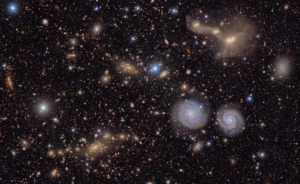When astronauts first step onto the Red Planet, they may be surprised to see that the sky is sometimes green. The European Space Agency’s (ESA) ExoMars Trace Gas Orbiter recently spotted the phenomenon around Mars.
The soft green glow was so bright at the poles that it would likely be visible from the surface. The glow “occurs when two oxygen atoms combine to form an oxygen molecule,” the ESA explained. This reaction takes place about 50km above the surface.
Green glow from oxygen

An artist’s impression of visible nightglow on Mars. Image: NASA/JPL-Caltech/Cornell University/Arizona State University
The oxygen atoms are initially part of carbon dioxide molecules on Mars’s dayside. Energy from the sun splits them from the carbon atoms. As they drift to the night side of the planet, the oxygen atoms lose energy and combine, emitting an eerie light.
You can also see a nightglow on Earth. The green luminescence looks similar to the northern lights. But the two phenomena have different causes. The northern lights occur when the Earth’s magnetic field affects charged particles from the sun, not when oxygen atoms combine.
Astronomers have long suspected that luminescence happens on Mars but have never observed it. Researchers noticed it on Mars 10 years ago in the infrared and ultraviolet spectrums, and in 2020, the Trace Gas Orbiter (TGO) picked up dayglow in the visible light spectrum. But the research team says that this is the first time anyone has observed nightglow: “Scattered solar light hinders such measurements from Earth…and no space-borne instrument has [previously] observed the Mars visible nightglow.”

Nightglow on Earth from the International Space Station. Photo: NASA
Why is Mars’s atmosphere so thin?
Monitoring and tracking the Mars nightglow will now be part of the TGO’s mission.
“[This] is an excellent tool for probing the composition and dynamics of Mars’ upper atmosphere between 40 and 80km,” atmospheric physicist Benoit Hubert told Live Science.
The glowing atmosphere helps us trace atmospheric circulation. Researchers hope it will eventually help them understand the composition of the Martian atmosphere and why it is so thin. Knowing this will be crucial for potential future missions to Mars.






